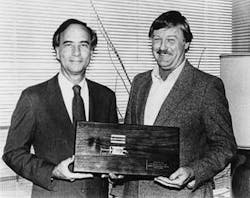
Irnee D’Haenens (right), a physicist who assisted Ted Maiman (left) in making the first laser at Hughes Research Laboratory (Malibu, CA) in 1960, died Dec. 24, 2007; he was 73. The two were the only people present when a little ruby rod emitted the world’s first pulse of laser light on May 16, 1960. Later, D’Haenens called the laser “a solution looking for a problem,” a joke that became common in the early years of the laser era as developers sought laser applications.
Born in Mishawaka, IN, the son of a service-station operator, D’Haenens spent his entire career at Hughes, starting while he was earning a masters degree from the University of Southern California. He received a Hughes doctoral fellowship and earned his Ph.D. from the University of Notre Dame in 1966. While at Hughes, he worked on semiconductor physics, microwave technology, and spectroscopy, as well as lasers, before retiring in 1989. A long-time Hughes colleague, David Pepper, recalled D’Haenens as “a wise and learned uncle, who helped me travel along my path in life,” whose first priority was always his family. He is survived by his wife Shirley, four children, 19 grandchildren, and three great-grandchildren.

Jeff Hecht | Contributing Editor
Jeff Hecht is a regular contributing editor to Laser Focus World and has been covering the laser industry for 35 years. A prolific book author, Jeff's published works include “Understanding Fiber Optics,” “Understanding Lasers,” “The Laser Guidebook,” and “Beam Weapons: The Next Arms Race.” He also has written books on the histories of lasers and fiber optics, including “City of Light: The Story of Fiber Optics,” and “Beam: The Race to Make the Laser.” Find out more at jeffhecht.com.